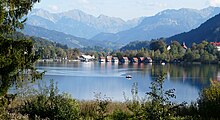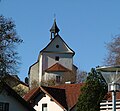Bühl am Alpsee
Bühl am Alpsee is a district in Immenstadt im Allgäu , it is about two kilometers west of the Großer Alpsee and has the title climatic health resort .
structure
The following settlements belong to Bühl
|
Furthermore, belonged to the former municipality of Buhl nor the deserts Bahnhäuseln , bleach goods and Gaiskopf
history
The Zaumberg part of the municipality belonged to the Weingarten monastery in the 12th, possibly as early as the 11th century . There a certain knight Heinrich von "Bihel" is named as Maier . Even before 1900 summer visitors from Germany and neighboring countries came to Bühl. In October 1899 a beautification association was founded there (later renamed the tourist association). Bühl was awarded the title climatic health resort in 1976.
In the course of the municipal reform , the municipal council of Bühl decided on December 15, 1971 to join the municipality of Immenstadt. This followed on January 1, 1972.
church
Affiliation
- 1472-1665: Kaplanei Buhl
- 1687–1957: Penitentiary or Kuratie Bühl
- At the request of the church administration and the parish council, Bishop Joseph Freundorfer raised the trusteeship to the Catholic parish to St. Stephanus in Bühl am Alpsee . Wilhelm Igel was confirmed as the first pastor of this parish on August 14th and was appointed to his office on September 8th.
- Today the Bühl parish belongs to the Immenstadt - Bühl - Rauhenzell parish community founded in 1999 . Bühl has its own pastor's office, but is also looked after from Immenstadt. The parish council is elected exclusively from Bühler citizens and works independently.
Church ensemble in Bühl
- The church ensemble in Bühl consists of the parish church of St. Stephan, the Holy Sepulcher Chapel of St. Salvator (lower church of St. Stephen), the pilgrimage chapel Maria Loreto and the Anna chapel . It is entered in the list of monuments under the numbers D-7-80-124-42 and D-7-80-124-43 .
Chapels in the parish
- Chapel of St. Cyprian in Gschwend: The first chapel in Gschwend was consecrated in 1734. In 1948 this church was demolished, and at the same time the altar from the old chapel in Ratholz with a temple corridor of St. Family performing painting was destroyed. In the same year, today's wooden structure was erected at a place a little west of the former location. The inauguration took place in August 1948. The bell cast in 1732 and a statue of the Virgin Mary from the late 15th century are particularly significant, while a Sebastian mentioned in 1939 and the two wooden figures of St. Rochus and St. Cyprian no longer exist. The latter were stolen on the night of November 13-14, 1993.
- Chapel of St. Martin in Ratholz: After the plans of the Thalkirchdorf master carpenter Joseph Anton Keck had been approved, the construction of the chapel of St. Martin in Ratholz was carried out in the summer of 1871 at the local people's own expense. In autumn one only waited for the consent of the episcopal ordinariate in Augsburg, then on November 28, 1871 the solemn inauguration of the chapel in honor of Saints Wendelin and Martin could take place. After a large-scale renovation in 1983/84, another repair was also completed in 2007. On the neo-Gothic altar from the time it was built there are primarily wooden figures of the two church patrons. Also noteworthy are a late 16th century St. Sebastian from the Bühler Stephanuskirche, as well as a bell from 1685 from the demolished Wendelin chapel with the coat of arms of the Königsegg rule. A picture of the Annunciation by the Bühl-born painter Johann Georg Grimm, which is still attested in 1939, has been lost.
- Marienkapelle in Reuter: So far there is no reliable knowledge of the origins of the chapel in Reuter. The current building dates from the 19th century, in earlier times the little church is said to have stood further down the mountain. In the chapel there are in particular statuettes that come from the pulpit of St. Stephen's Church in Bühl, which was destroyed in 1953. The chapel was originally dedicated to Wendelin, the patron of the cattle. In the period after the Second World War, the name “Marienkapelle” became common.
- Chapel of St. Sebastian in Trieblings: It is generally assumed that the original chapel by Trieblings was built in 1791, because this date was found in an oak lintel of the church. The Immenstadt parish priest received permission for consecration at the same time as the permit for a trade fair on November 27, 1798. In 1933, the chapel was finally rebuilt, although care was taken that the building corresponded to the old shape. In Trieblings, the saint of the plague, Sebastian, is venerated, for example in the altar panel from 1894, which is integrated into a late 18th century Rococo altar.
- St. Leonhard Chapel in Zaumberg: Zaumberg was mentioned as early as 1090 as a property belonging to the Weingarten Monastery. Even under Weingarten rule, a first chapel was supposedly built between 1432 and 1444 in honor of Mary and Saints Leonhard, Agatha, Johannes and Paul . After another chapel, presumably the successor to the late medieval church, had been demolished, a new building was built in another location in 1790, today's St. Leonhard Chapel. The painting as part of a restoration in 1885 goes back to the Zaumberg brothers Alois and Andreas Schmid, who were both important theologians of their time and were considered patrons of the chapel. Some of the figures in the Zaumberg church are significant from an art-historical point of view, such as a standing Mother of God with a crescent moon, St. Agatha and St. Leonhard, all three of which date from around 1470/80 and which A. Miller considered the most attractive achievements of Allgäu art Late Gothic.
Art in Bühl
- The Bühler Swan , bronze sculpture by Gertrud Nein (* 1944; † 2012)
- Windsurfer , sculpture by Willi Tannheimer
gallery
View from the Horn to the Kleiner Alpsee and Bühl (left in the picture)
Personalities born in Bühl
- Benedikt Erhardt (life dates unknown), sculptor of the 18th century
- Magnus Jocham (* 1808; † 1893), professor of theology
- Johann Georg Grimm (* 1846; † 1887), landscape painter
- Xaver Rasch (* 1877 - † 1945), wood sculptor
- Otto Rasch (* 1909, † 1945), son of Xaver Rasch , wood sculptor
- Albert Rasch (* 1911; † 1993), son of Xaver Rasch , wood sculptor
traffic
Bühl am Alpsee is on the Munich – Lindau railway line .
literature
- Gerhard Klein, chapels in the parish area, in: St. Stephan - Bühl, a living parish of 50 years, ed. v. Parish of St. Stephan, Immenstadt 2007, pp. 17-20
- Werner Schnell, Bühl. St. Stephan with Holy Sepulcher Church, pilgrimage church Maria Loreto (Schnell Art Guide, No. 614), 5th edition Regensburg 2006
- Rudolf Vogel (Ed.): Immenstadt im Allgäu - landscape, history, economy, cultural and religious life over the centuries. J. Eberl KG, Immenstadt 1996
Web links
Individual evidence
- ^ Wilhelm Volkert (ed.): Handbook of Bavarian offices, communities and courts 1799–1980 . CH Beck, Munich 1983, ISBN 3-406-09669-7 , p. 571 .
- ^ Art history (s) about Benedikt Erhardt
- ^ Art history (s) in the Allgäuer Anzeigeeblatt about Xaver Rasch
- ^ Art history (s) about Otto and Albert Rasch
Coordinates: 47 ° 34 ′ 10 ″ N , 10 ° 11 ′ 31 ″ E






















